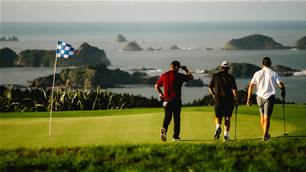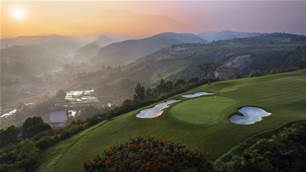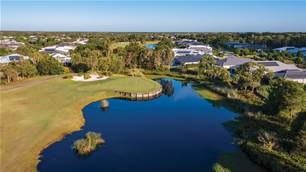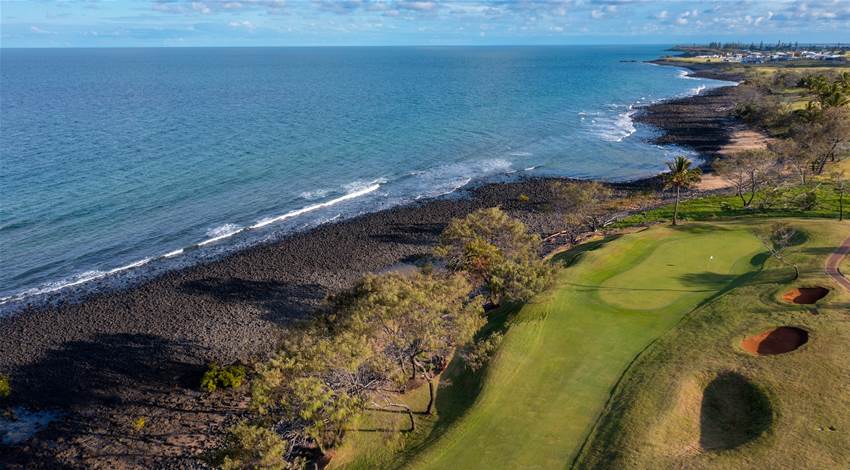In a region of Queensland perhaps best known for seemingly endless fields of sugar cane that occasionally make way for beef grazing lands and lush rainforests, there are eight golf courses to enjoy when you’re not spotting whales or soaking up the tropical sun.
We’re a nation of road-trippers. Driving holidays have long been a part of the Australian psyche, hitting the road with the car packed to the brim ready to discover another corner of this great land.
For golfers, there are plenty of great road trips of varying lengths to be found right across the country. There are the obvious ones, like tripping between the renowned Murray River courses or spending a week in Victoria’s Gippsland or South Australia’s Limestone Coast.
Then there are the golfing paths less travelled. One of which I recently followed from historic Maryborough, on Queensland’s Fraser Coast, north to Bundaberg and on to Australia’s beef capital, Rockhampton, in the heart of the picturesque Capricron Coast region. It’s a 430km scenic journey punctuated by eight rounds of golf, a few sips of rum and a rump steak dinner of the highest order.
Three hours into the drive from Brisbane Airport I rolled into Maryborough – the 1889 birthplace of author Pamela Lyndon Travers, who created Mary Poppins (you can see her statue in Richmond St) – and the car park of the Maryborough Golf Club. I had heard this layout was a hidden gem and I certainly wasn’t disappointed.

The first really memorable hole is the 363-metre par-4 8th where a huge lake skirts the left edge of the fairway as it doglegs gradually from right to left. From the tee, you can hit your driver over the water and most players will be left with a mid- or short-iron into the large green, which sits just beyond the edge of the lake and is surrounded by several bunkers.
The following hole is not as daunting but it’s no less challenging. The 120-metre par-3 calls for a short iron approach over the edge of the aforementioned lake to a green that is perched above the water line and cut into the side of a hill. It is a long, narrow putting surface where the front pin position is close to a three-club shorter shot than it is for a back flag. Two bunkers right of the green add to the accuracy required here.
Taking the scenic route to Bundaberg, I headed for Hervey Bay. The bay is probably best known for its whale watching tours and its easy access to the world heritage-listed Fraser Island. The Esplanade here is a great spot for dining or to grab a coffee or to just relax and soak in the view.
The Hervey Bay Golf and Country Club has been on its present site since 1945 and was extended to become an 18-hole layout in the late 1970s.
In recent times, the club has entered into a step-by-step program of upgrading its greens, renovating bunkers and carrying out improvement work. To oversee major works, Hervey Bay commissioned course architect Richard Chamberlain to design new green complexes, while experienced local golf course shaper Rob Snell has been contracted to carry out the earthworks.

The 295-metre par-4 8th was the first to undergo change with the green more than doubled in size and the surrounds given more definition with mounds and hollows as well as a deep greenside bunker. The new green opened four months ago and the Tifeagle surface is already beautifully smooth and rolling at a good speed, while the TifTuf surrounds provide a tight surface that offer a wide range of chipping options.
Next up is Hervey Bay’s signature hole, the 316-metre downhill par-4 16th, which was due to open for play earlier this month. What was a relatively flat putting surface, has been lowered in the front leaving a significant slope from back-to-front, while a small bowl front left adds plenty of interest and will surely see some brave players hole their second shot approach. The green is now closer to the lake, so there will be as many bogeys, and doubles, as birdies here.
The downhill 377-metre par-4 11th hole is one of Hervey Bay’s most memorable offerings. A wide fairway allows you to open the shoulders and give your tee shot a real crack but it is the approach where caution is required. A lake cuts into the fairway from the left, about 60 metres short of the green, and there are several bunkers surrounding the large green. It is a tough second shot but you’ll feel pretty pleased with yourself if you have a birdie attempt here.
Hervey Bay’s longest journey comes two holes later. At 537 metres, this par-5 is a challenge for even the most prodigious hitters. The fairway is wide from the tee, however the fairway does narrow on approach with water on the left and trees lining the right. The long, narrow green is protected left and right by bunkers. A birdie, even a par, here is well-earned.

Increasingly cloudless skies followed me for the 100-minute drive north to Bundaberg. I made a brief detour to the Bundaberg rum distillery, to stock up on supplies of the beautiful golden liquid.
The first barrel of Bundy rum was produced back in 1888, well before the first shots were struck at Bundaberg Golf Club, six kiometres away on the north side of the Burnett River.
Bundaberg is an easy-walking layout that measures a shade under 6,000 metres from the tips. This might suggest that longer hitters will have a field day here but many of the fairways are heavily tree-lined and dogleg to varying degrees either left or right. In fact, there are only a few straight holes, and these are usually punctuated by fairway bunkers.
Bundaberg’s most memorable hole is the 145-metre par-3 2nd. The tee shot is played from an island tee and must carry a large lake for most of the journey to the green. The best possible miss here is to the right of the putting surface but it still leaves a difficult chip and putt to save par.
I was impressed with the presentation of the layout at Bundaberg, in particular the greens. Bundaberg’s putting surfaces are as smooth as a nip of the beautiful rum produced down the road.

There are two more courses, closer to the coast, to scratch your golfing itch while in Bundaberg. Coral Cove is an integrated golf resort and residential community covering 400 acres.
The course was fully completed in 2000, while Bundaberg’s old Base Hospital building was relocated to the site and fully restored to become the clubhouse. The Queenslander-style building offers lovely views over the course and the Coral Sea.
Coral Cove has been designed to be enjoyed by a wide-ranging level of golfers. There are four tees per hole and most of the fairways offer generous landing areas. The landscape varies from coastal links on the first two holes, to a resort-style lake course and on to natural wooded bush on several holes well away from the sea. The course is well spread between pockets of real estate so carts are compulsory as a result. With so much land to spare, I was surprised to find the 1st hole is a 235-metre par-4. The green is certainly within range for long-hitters who will stand on the tee and lick their chops in anticipation of getting off to a birdie start. But they must be wary as they head towards the Pacific Ocean as there are fairway mounds surround the landing area just short of the green, which is surrounded by bunkers.
The seaside par-3 2nd is widely-regarded as the best hole at Coral Cove. From the men’s and ladies markers the hole measures 168 metres and runs uninhibited along the Coral Sea shoreline. The championship plates are 40 metres left on a small point. From here a long tee shot over the volcanic rock shore – and crystal clear waters at high tide – is needed to find the green, which is quite narrow and long. The green is so long that it is a 240-metre carry to the back third of the green.
The 12th hole here is worth mentioning. This is a controversial hole and one that generates much discussion from those that play it. At 635-metres, this is Australia’s only par-6 hole. Yes, a par-6. This area of the course is set in gently rolling natural bushland, with mature blue gums lining the fairways. It is three strong hits to reach the upturned saucer green and set up a putt for an eagle ‘four’.

Bargara, about 10 minutes’ drive north of Coral Cove, is a popular seaside village of nearly 7,000 that swells considerably during the holidays. And it’s no wonder with two wonderful beaches, terrific cafes and restaurants as well as a pretty good golf course.
Bargara Golf Club offers ocean views from the clubhouse, while the 1st tee is about 200 metres from the ocean. The layout covers a well-drained sand base and is easily affected by sea breezes, adding to the challenge on a tight course that weaves between low-lying casuarina trees and strategically-placed bunkers. There are some long demanding par-4s and 5s, but it was the par-4 2nd that I will remember as one of my favourites. The 247-metre hole bends gently from left-to-right and long hitters may be encouraged by this with a view to driving the green. But trouble awaits over the seemingly endless line of casuarinas flanking the right. A long, deep bunker – straight from the Dr Alistair Mackenzie school of bunker design – lies 30 metres short of the green on the ‘short cut line’ to the green. A second bunker cuts into the right edge of the tiered putting surface, which falls steeply away to the left into long rough. This a great sleeper hole! The journey north to Rockhampton from Bargara was about 300km via the Bruce Highway and winds its way through some very picturesque and lush tropical Queensland countryside.
Straddling the Fitzroy River, Rockhampton is known as the beef capital of Australia. Any sceptic of the claim, need only to drive down the main street and check out the six cow statues – each representing the six different breeds found in the region.
The river was the backdrop to Rockhampton’s original nine-hole course, which was formed in 1898 but closed in 1911.
In 1920, the Rockhampton Golf Club was reformed and moved to its current location, south west of the city centre near the botanical gardens and zoo.
And can you imagine the scenes a decade on when the legendary American golfer Walter Hagen played an exhibition match with one of Australia’s finest, Joe Kirkwood.
The local paper, The Morning Bulletin, reviewed the event. “Never in its history has Rockhampton seen, and for many years it is not likely to see again, such an excellent display of golf as that witnessed at the local links on Saturday afternoon, when Walter Hagen and Joe Kirkwood; the former the world’s open champion and the latter the world’s trick shot artist – appeared in an 18-hole exhibition match. Hagen won 3 up and 1 to play. There was a most enthusiastic gallery, and it is pleasing to note that the club will come out on the right side financially.”
The course Hagen and Kirkwood played had to be changed with the extension in the late 1960s of the main runway of the nearby airport. Acclaimed course architect Al Howard was commissioned to design the layout, which opened for play in September 1970 and the routing remains largely unchanged to this day.

The opening hole sets the scene for the rest of the round, with water coming into play on the 537-metre double-dogleg trek from tee-to-green. Further into the front nine, the long par-3 7th and the par-4 dogleg right of 294 metres play either side of a large lake.
Water also comes into play late on the back nine, and it is the tee shot on the short dogleg right par-4 17th you might recall ahead of others. On the tee, the view across the lagoon to the botanic gardens was beautiful in the early morning light when I was there. The lagoon lines the right side of the hole and is an easy target for sliced tee shots.
Next stop … Yeppoon, which lies on Keppel Bay at the gateway to the southern Great Barrier Reef, about 40 minutes’ drive north east of central Rocky.
Yeppoon Golf Club covers gently undulating land on the western edge of the town. While the course only stretches to a par-71 of 5,731 metres, it is a tight excursion that winds between strands of tall trees, over and alongside several water hazards and has out-of-bounds coming into play on eight holes.

Yeppoon’s toughest and most memorable hole comes early in the round. The superb 432-metre sharp dogleg left 3rd hole offers classic risk-reward options. A good drive around the dam to the corner leaves 200 metres to a well protected green, while a tee-shot across the dam shortens the second shot approach but you must be definite about your playing line over the water. Interestingly, the artist’s palette-shaped green is one of only two on the course that predominantly slope towards the ocean.
One of Yeppoon’s sleeper holes is the 285-metre downhill, and gunbarrel straight, par-4. Most players will not need a driver from the tee here, so answering the club selection question on the tee is key to scoring well here, like getting to the flattest area of the fairway, which happens to be closest to the water separating the sloping green from the fairway. I can’t imagine how many short iron and wedge shots have been hit fat on a downhill lie here and dropped into a watery grave short of the target.
Yeppoon is an interesting layout that demands some really fun shots – like the downhill pitch on the 7th hole, the tee shot on the par-3 8th or the uphill approach into the heavily contoured 15th green – among a host of challenging ones.
I’ll confess here, I’d never heard of Emu Park Golf Club – about 15 minutes’ drive south of Yeppoon Golf Club – until I started organising this road trip. And what a pleasing surpise it was.
The clubhouse stands on the highest point of the property with most of the holes laid out below to the south and west.

It’s primary challenge to making a good score is finding the smallish greens with your approach shots. It is not a heavily bunkered course but the fairways are relatively narrow.
For mine, Emu Park leaves its best for last and the sternest closing holes of any course featured here. The two hardest rated holes at Emu Park are the long par-5 17th (No.2) and the 401-metre 18th (No.1).
Standing on the tee of the 517-metre penultimate hole, the straight bunkerless fairway leads away from near the clubhouse and offers a view of Keppel Bay off in the distance. The fairway turns sharply left within a wedge of the wide green, that is tucked slightly behind trees and features two bunkers beyond its back fringe.
The 401-metre closer is a beauty. Again, it’s a straight fairway that is cut in two by a water hazard about two thirds of the way to the green, where two deep pot bunkers pinch into its front edge and intimidate the player with a long approach.
A round at Emu Park, with its meagre $25 green fee, offers terrific golfing value for money.
With the golf aspect of the road trip over, I headed back to Rockhampton and the historic and beautifully appointed Criterion Hotel. The pub was built in 1867 and is today the home of the Bush Inn steak house, which is renowned for its extensive beef menu. I went with the 400g rump steak and, like the a round at Emu Park, it was great value for money.
*NOTE. Capricorn Golf, home of the former nationally ranked championship course designed by American Karl Litten, requestednot to be featured in this article.
Related Articles

Touring New Zealand: The complete golfing package

World Exclusive: Trump’s Indonesian Tee-off








_15th_hole.jpg&h=115&w=225&c=1&s=1)




